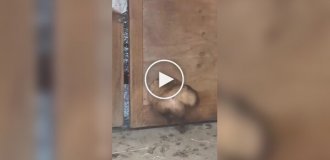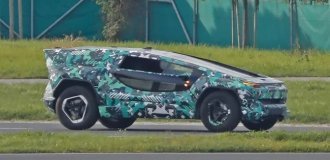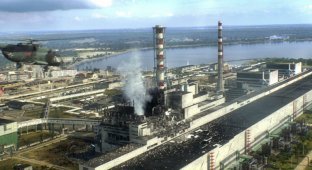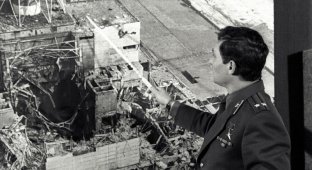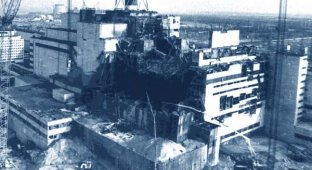How the decontamination of Pripyat took place (24 photos)
The decontamination of Pripyat cost serious victims, since many liquidators of the consequences of the explosion at the Chernobyl nuclear power plant received a large share of radiation. Now there is a lot of debate about the feasibility of these works, because already in May 1986 it was clear that it would not be possible to live the same life in Pripyat. Nevertheless, decontamination helped to avoid the massive spread of radioactive objects outside the exclusion zone, although looters are still finding something to profit from. In this post we will take a look at how the work to decontaminate the city of nuclear scientists took place.
First, let's evaluate the scale of the work. Here is a post-accident photo of Pripyat - this is the spring or early summer of 1986; Almost the entire city was included in the photo. As you can see, Pripyat was very small and compact - 5 microdistricts, each of which was a large block. The whole city is similar in size to a residential neighborhood in a city like Minsk or Kyiv. However, the decontamination work was quite extensive, because it was necessary to remove radioactive soil - even in such a small area this amounts to hundreds of tons.

Now let's look at this map. On it you can see the location of the city relative to the Chernobyl nuclear power plant, plus on the map I marked the microdistricts of the city, as well as the main flows through which radioactive emissions dispersed. To some extent, Pripyat was lucky - during the days of the accident, the wind was such that the main radioactive masses seemed to “bend around” the city on both sides, forming two lines of high radiation contamination, which were later called the Northern and Western traces. Even taking this into account, the exposure background in Pripyat by the evening of April 26 averaged 1 roentgen per hour (about 70-100 thousand times higher than normal); you can imagine what the background would be like in Pripyat if the flows went straight to the city.

Almost immediately after the accident, the city acquired the “special status” of a closed settlement. In order to get to Pripyat, you had to have a special pass; they came in different levels of access - “Pass to Chernobyl”, “Pass to Pripyat”, “Pass everywhere”. Documents were checked at the entrance to the city; It was absolutely unrealistic for a random person to get to Pripyat at that time.

All deactivation activities can be divided into two main types of work - washing buildings from traces of radioactive dust and cleaning up soil - all main work falls under these two categories, plus we will also add a separate item for the removal of things to burial grounds. The photo below shows the decontamination of the dormitories of the Jupiter plant; as you can see from the map, in those parts of the city the background was quite high (and in general, in the Jupiter area, even now it is quite dirty).

The buildings were washed with the help of these special fire engines, which provided the necessary pressure. Regarding what they washed with, I came across different versions. Some write that it was ordinary water, while others say that it was a special polymer composition, which, when dried, turned into some kind of analogue of a film that bound dust and which could then be collected as garbage.

I think that both versions are plausible - in some places they could have used a special compound, and in others - ordinary water. In general, neither concrete nor brick are “activated” by radiation in any way (unlike metal) and are washed quite easily - you just need to remove all the dust and radioactive particles.

Preparatory work is filmed here - apparently, filling the car's tank through a special hose.

A photograph of the laundering process. As you can see, the jet is strong enough to reach the upper floors of a typical nine-story building. I think that the pressure had to be adjusted depending on the height - after all, with a jet of such force that reaches the upper floors, you can easily break out the windows on the lower floors.

In addition to fire trucks, at least one BelAZ, converted into a UMP-1 watering truck, was also used to clean buildings. In the photo below you can see this car washing roads on Lenin Avenue, which runs between the First and Second microdistricts of the city. I think that BelAZ was initially planned to be used for cleaning tall sixteen-story buildings, but the water compressor was too strong - according to eyewitnesses, the stream of water from BelAZ easily knocked out windows in houses.

Another part of the work (much more large-scale) involved the removal of radioactive soil and, apparently, was carried out after the buildings had been cleaned. The soil was collected in different ways everywhere. Somewhere these graders were used to cut the soil.

But basically everything was done by hand. In the photo below, a group of decontamination service soldiers manually collects soil into the back of a MAZ, the photo was taken in the courtyard of Pripyat hostels in the First or Second Microdistrict.

Collection of soil on the territory of one of the kindergartens. As can be seen from the exposed curbs, the earth was removed quite deeply.

More soil collection:

Loading soil into the car body. I will assume that the equipment was used somewhere in the area of the Jupiter plant, where radiation levels were significantly higher than in other microdistricts.

As can be seen in some photos, the soil was cut not only with shovels, but also with some kind of hoe. In the middle of the frame you can see a dosimetrist conducting field measurements of exposure dose with something like a military dosimeter DP-5.

Break in work The soil on the left side of the lawn has already been razed, on the right it still needs to be done.

Collecting soil into trucks in one of the yards.

Control measurements of the decontaminated area, apparently this is some kind of kindergarten. Interesting details in the photo - for some reason the windows of the supposed kindergarten are covered with film, and for some reason there is no glass at all in the windows of the top floor of the high-rise building in the background. There is an assumption about the film - the kindergarten was used as a dormitory for liquidators in the spring and summer of 1986, and the film served as an additional dust filter.

Military in Pripyat.

Construction.

A rare photo of disinfectants working; Most likely this is late autumn 1986. All things are taken out of houses (some are simply thrown out through windows), collected in trailers and bodies and transported to burial grounds.
Only a few large-sized things like “walls” and sofas remain in the houses.

Collection and removal of contaminated items, area of the "Sporting Goods" store.

A fire escape near one of the Pripyat houses - I assume that things were collected in this way, which were then supposed to be used inside the perimeter of the ChEZ.

BRDM-2 on the city streets.








